Quad-Trapezoidal-Leg Orthoplanar Spring with Piezoelectric Plate for Enhancing the Performances of Vibration Energy Harvester
Abstract
1. Introduction
2. Design and Analysis
2.1. Modeling of the Basic Structure
2.2. Construction of the PVEH
3. Prototypes and Experiments
4. Results
4.1. Results for Case 1-Based Prototypes
4.2. Results for Case 2-Based Prototypes
4.3. Discussion
5. Conclusions
Author Contributions
Funding
Conflicts of Interest
References
- Toprak, A.; Tigli, O. Piezoelectric energy harvesting: State-of-the-art and challenges. Appl. Phys. Rev. 2014, 1, 031104. [Google Scholar] [CrossRef]
- Liu, Y.; Wang, H.; Zhao, W.; Zhang, M.; Qin, H.; Xie, Y. Flexible, stretchable sensors for wearable health monitoring: Sensing mechanisms, materials, fabrication strategies and features. Sensors 2018, 18, 645. [Google Scholar] [CrossRef] [PubMed]
- Yildirim, T.; Ghayesh, M.H.; Li, W.; Alici, G. A review on performance enhancement techniques for ambient vibration energy harvesters. Renew. Sustain. Energy Rev. 2017, 71, 435–449. [Google Scholar] [CrossRef]
- Yang, Z.; Zhou, S.; Zu, J.; Inman, D. High-performance piezoelectric energy harvesters and their applications. Joule 2018, 2, 642–697. [Google Scholar] [CrossRef]
- Tran, N.; Ghayesh, M.H.; Arjomandi, M. Ambient vibration energy harvesters: A review on nonlinear techniques for performance enhancement. Int. J. Eng. Sci. 2018, 127, 162–185. [Google Scholar] [CrossRef]
- Luo, C.; Xu, H.; Wang, Y.; Li, P.; Hu, J.; Zhang, W. Unsymmetrical, interdigital vibration energy harvester: Bandwidth adjustment based on mode separation technique. Sens. Actuators A Phys. 2017, 257, 30–37. [Google Scholar] [CrossRef]
- Deng, H.; Du, Y.; Wang, Z.; Zhang, J.; Ma, M.; Zhong, X. A multimodal and multidirectional vibrational energy harvester using a double-branched beam. Appl. Phys. Lett. 2018, 112, 213901. [Google Scholar] [CrossRef]
- Aldraihem, O.; Baz, A. Energy harvester with a dynamic magnifier. J. Intell. Mater. Syst. Struct. 2011, 22, 521–530. [Google Scholar] [CrossRef]
- Li, X.; Upadrashta, D.; Yu, K.; Yang, Y. Analytical modeling and validation of multi-mode piezoelectric energy harvester. Mech. Syst. Signal Process. 2019, 124, 613–631. [Google Scholar] [CrossRef]
- Tang, L.; Yang, Y. A multiple-degree-of-freedom piezoelectric energy harvesting model. J. Intell. Mater. Syst. Struct. 2012, 23, 1631–1647. [Google Scholar] [CrossRef]
- Daqaq, M.F.; Masana, R.; Erturk, A.; Dane Quinn, D. On the role of nonlinearities in vibratory energy harvesting: A critical review and discussion. Appl. Mech. Rev. 2014, 66, 040801. [Google Scholar] [CrossRef]
- Pellegrini, S.P.; Tolou, N.; Schenk, M.; Herder, J.L. Bistable vibration energy harvesters: A review. J. Intell. Mater. Syst. Struct. 2012, 24, 1303–1312. [Google Scholar] [CrossRef]
- Andò, B.; Baglio, S.; Bulsara, A.R.; Marletta, V. A bistable buckled beam based approach for vibrational energy harvesting. Sens. Actuators A Phys. 2014, 211, 153–161. [Google Scholar] [CrossRef]
- Fan, K.; Tan, Q.; Liu, H.; Zhang, Y.; Cai, M. Improved energy harvesting from low-frequency small vibrations through a monostable piezoelectric energy harvester. Mech. Syst. Signal Process. 2019, 117, 594–608. [Google Scholar] [CrossRef]
- Shan, G.; Wang, D.F.; Song, J.; Fu, Y.; Yang, X. A spring-assisted adaptive bistable energy harvester for high output in low-excitation. Microsyst. Technol. 2018, 24, 3579–3588. [Google Scholar] [CrossRef]
- Zhou, S.; Cao, J.; Litak, G.; Lin, J. Numerical analysis and experimental verification of broadband tristable energy harvesters. tm-Tech. Messen 2018, 85, 521–532. [Google Scholar] [CrossRef]
- Deng, H.; Wang, Z.; Du, Y.; Zhang, J.; Ma, M.; Zhong, X. A seesaw-type approach for enhancing nonlinear energy harvesting. Appl. Phys. Lett. 2018, 112, 213902. [Google Scholar] [CrossRef]
- Kwon, D.-S.; Ko, H.-J.; Kim, M.-O.; Oh, Y.; Sim, J.; Lee, K.; Cho, K.-H.; Kim, J. Piezoelectric energy harvester converting strain energy into kinetic energy for extremely low frequency operation. Appl. Phys. Lett. 2014, 104, 113904. [Google Scholar] [CrossRef]
- Kathpalia, B.; Tan, D.; Stern, I.; Erturk, A. An experimentally validated model for geometrically nonlinear plucking-based frequency up-conversion in energy harvesting. Smart Mater. Struct. 2018, 27, 015024. [Google Scholar] [CrossRef]
- Parise, J.J.; Howell, L.L.; Magleby, S.P. Ortho-planar linear-motion springs. Mech. Mach. Theory 2001, 36, 1281–1299. [Google Scholar] [CrossRef]
- Nabavi, S.; Zhang, L. Nonlinear multi-mode wideband piezoelectric mems vibration energy harvester. IEEE Sens. J. 2019, 19, 4837–4848. [Google Scholar] [CrossRef]
- Dhote, S.; Yang, Z.; Zu, J. Modeling and experimental parametric study of a tri-leg compliant orthoplanar spring based multi-mode piezoelectric energy harvester. Mech. Syst. Signal Process. 2018, 98, 268–280. [Google Scholar] [CrossRef]
- Dhote, S.; Zu, J.; Zhu, Y. A nonlinear multi-mode wideband piezoelectric vibration-based energy harvester using compliant orthoplanar spring. Appl. Phys. Lett. 2015, 106, 163903. [Google Scholar] [CrossRef]
- Dhote, S.; Li, H.; Yang, Z. Multi-frequency responses of compliant orthoplanar spring designs for widening the bandwidth of piezoelectric energy harvesters. Int. J. Mech. Sci. 2019, 157–158, 684–691. [Google Scholar] [CrossRef]
- Wang, P.; Zhao, Y.; Tian, B.; Liu, Y.; Wang, Z.; Li, C.; Zhao, Y. A piezoresistive micro-accelerometer with high frequency response and low transverse effect. Meas. Sci. Technol. 2017, 28, 015103. [Google Scholar] [CrossRef]
- Savarimuthu, K.; Sankararajan, R. Design and analysis of cantilever based piezoelectric vibration energy harvester. Circuit World 2018, 44, 78–86. [Google Scholar] [CrossRef]
- Bao, M.-H. Micro Mechanical Transducers: Pressure Sensors, Accelerometers and Gyroscopes; Elsevier: Amsterdam, The Netherlands, 2000. [Google Scholar]
- Sader, J.E.; White, L. Theoretical analysis of the static deflection of plates for atomic force microscope applications. J. Appl. Phys. 1993, 74, 1–9. [Google Scholar] [CrossRef]
- Slattery, A.D.; Blanch, A.J.; Shearer, C.J.; Stapleton, A.J.; Goreham, R.V.; Harmer, S.L.; Quinton, J.S.; Gibson, C.T. Characterisation of the material and mechanical properties of atomic force microscope cantilevers with a plan-view trapezoidal geometry. Appl. Sci. 2019, 9, 2604. [Google Scholar] [CrossRef]
- van Kempen, R.B.; Herder, J.L.; Tolou, N. A Strain Distribution Based Classification of Ortho-Planar Springs: An Outlook to Piezoelectric Applications. In ASME 2016 International Design Engineering Technical Conferences and Computers and Information in Engineering Conference; ASME: Charlotte, NC, USA, 2016; Volume 4, p. V004T008A013. [Google Scholar]
- Wang, L.; Ding, J.; Jiang, Z.; Luo, G.; Zhao, L.; Lu, D.; Yang, X.; Ryutaro, M. A packaged piezoelectric vibration energy harvester with high power and broadband characteristics. Sens. Actuators A Phys. 2019, 295, 629–636. [Google Scholar] [CrossRef]
- Wang, L.; Zhao, L.; Jiang, Z.; Luo, G.; Yang, P.; Han, X.; Li, X.; Maeda, R. High accuracy comsol simulation method of bimorph cantilever for piezoelectric vibration energy harvesting. AIP Adv. 2019, 9, 095067. [Google Scholar] [CrossRef]
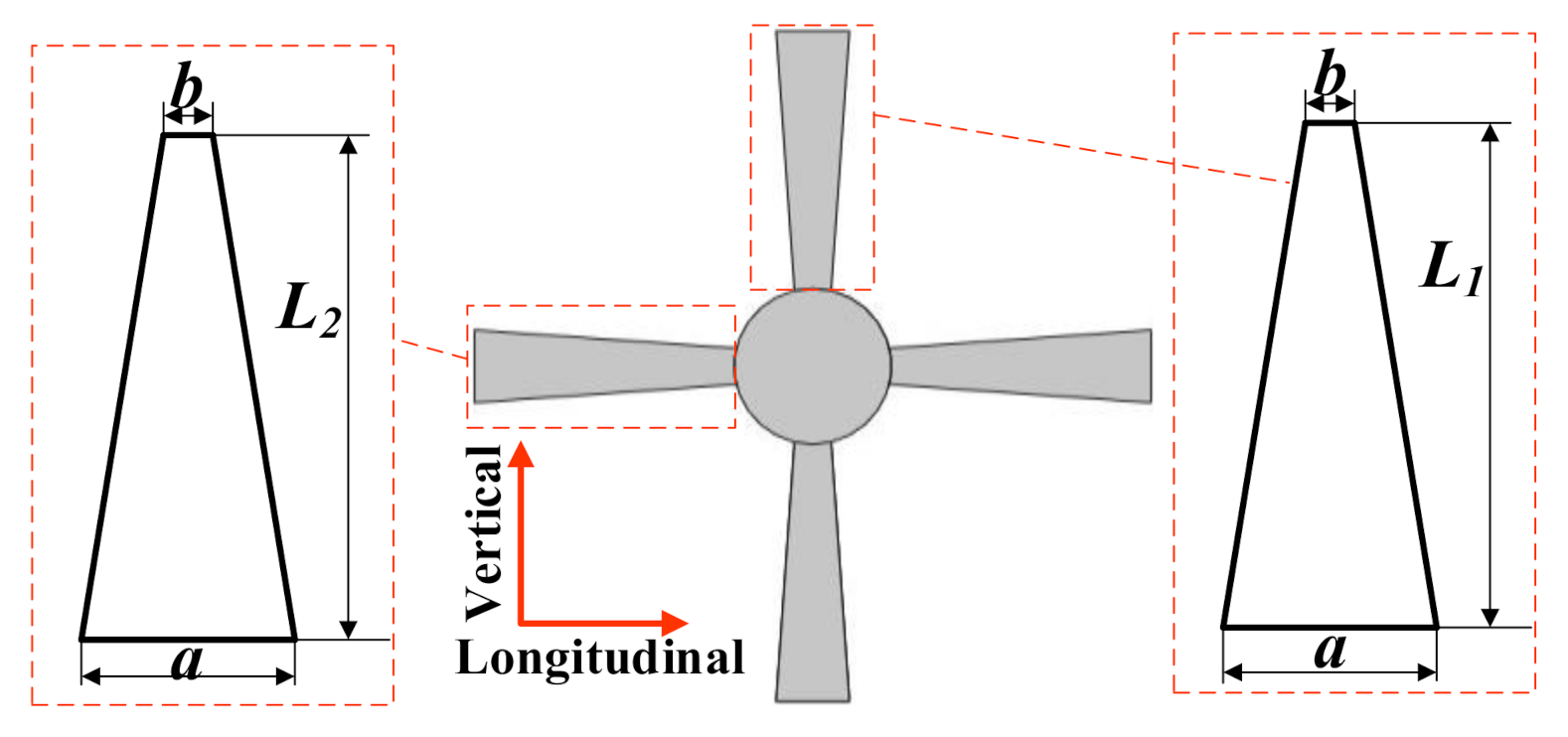
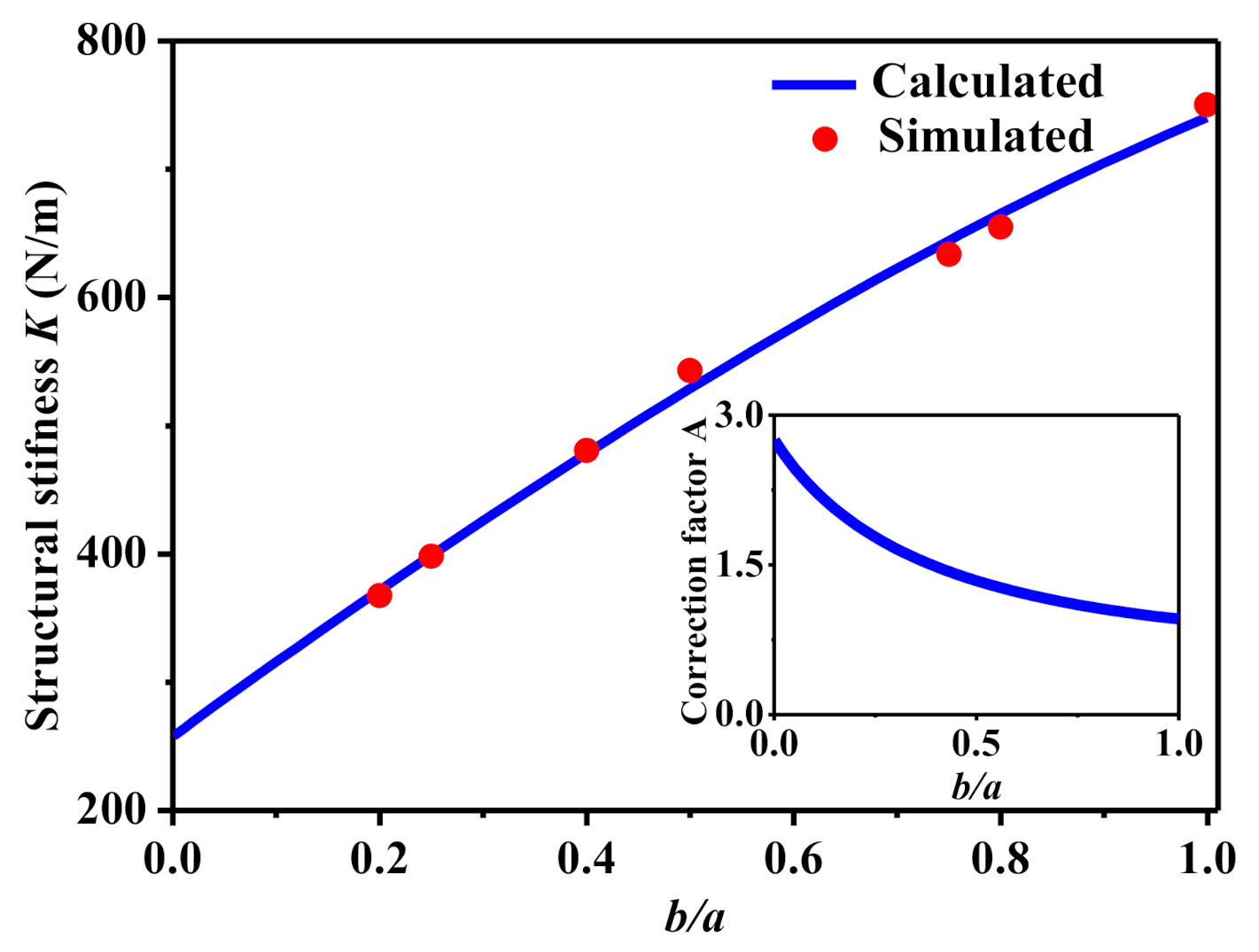
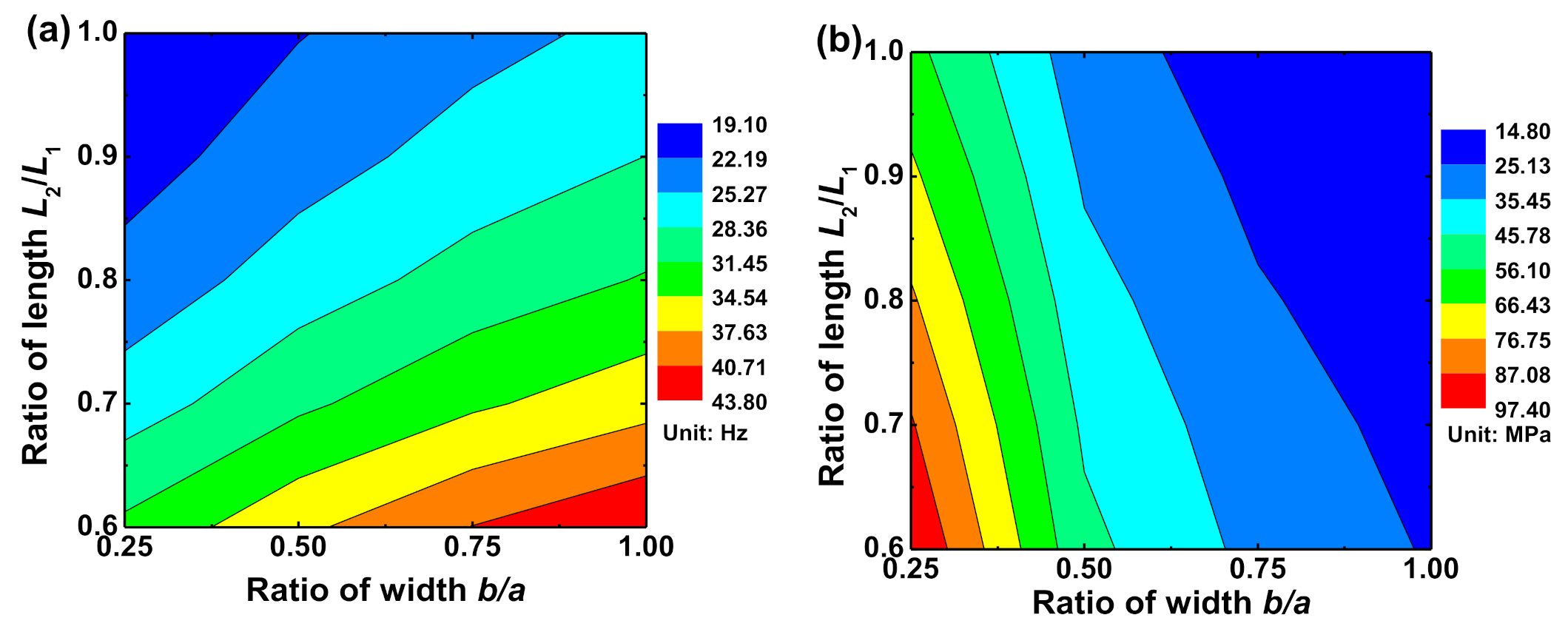
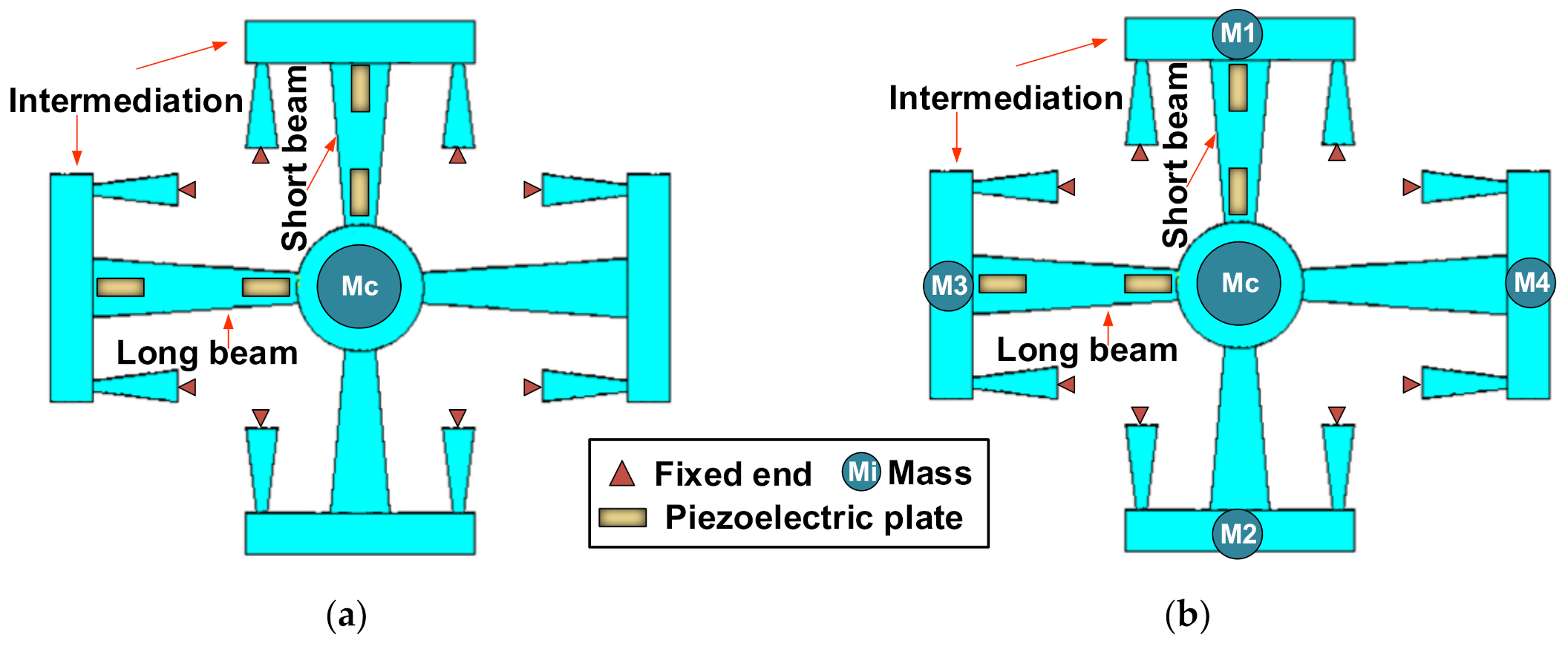
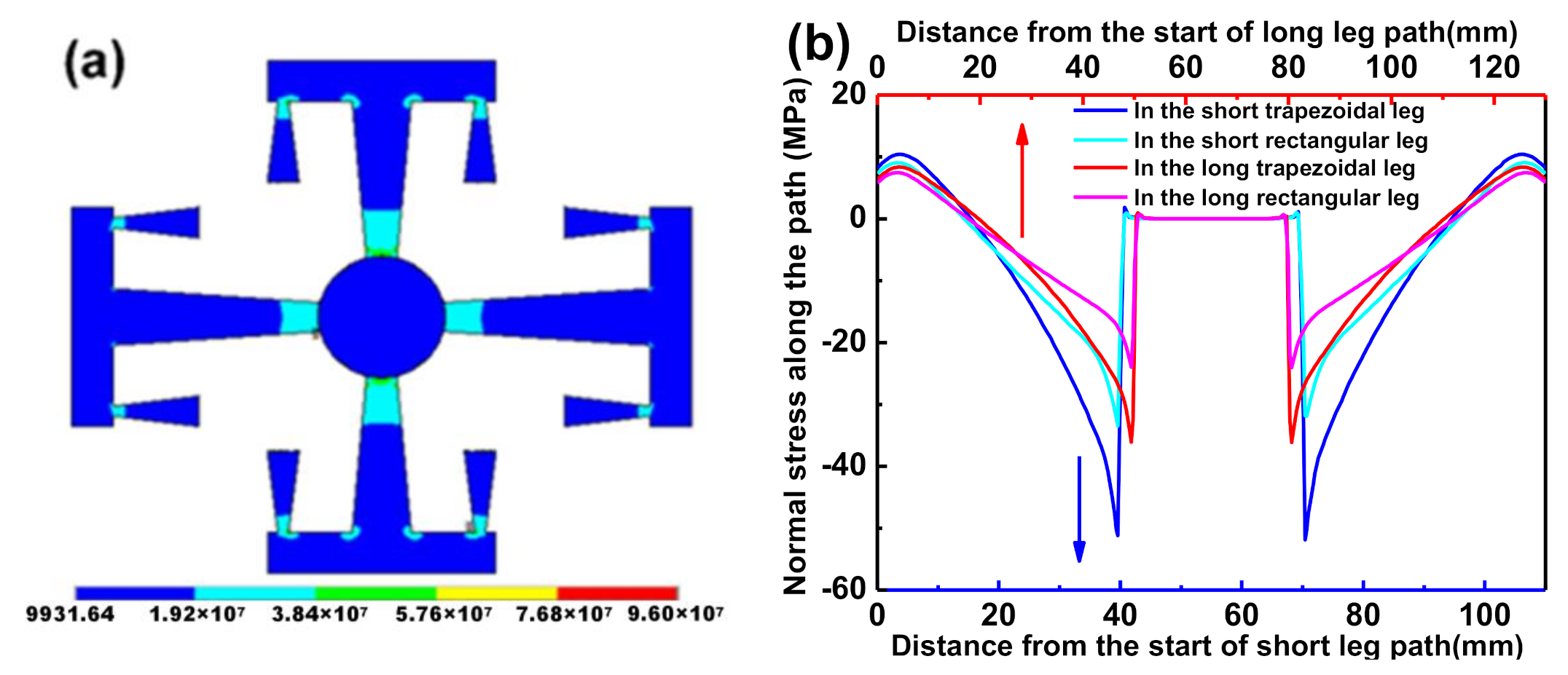
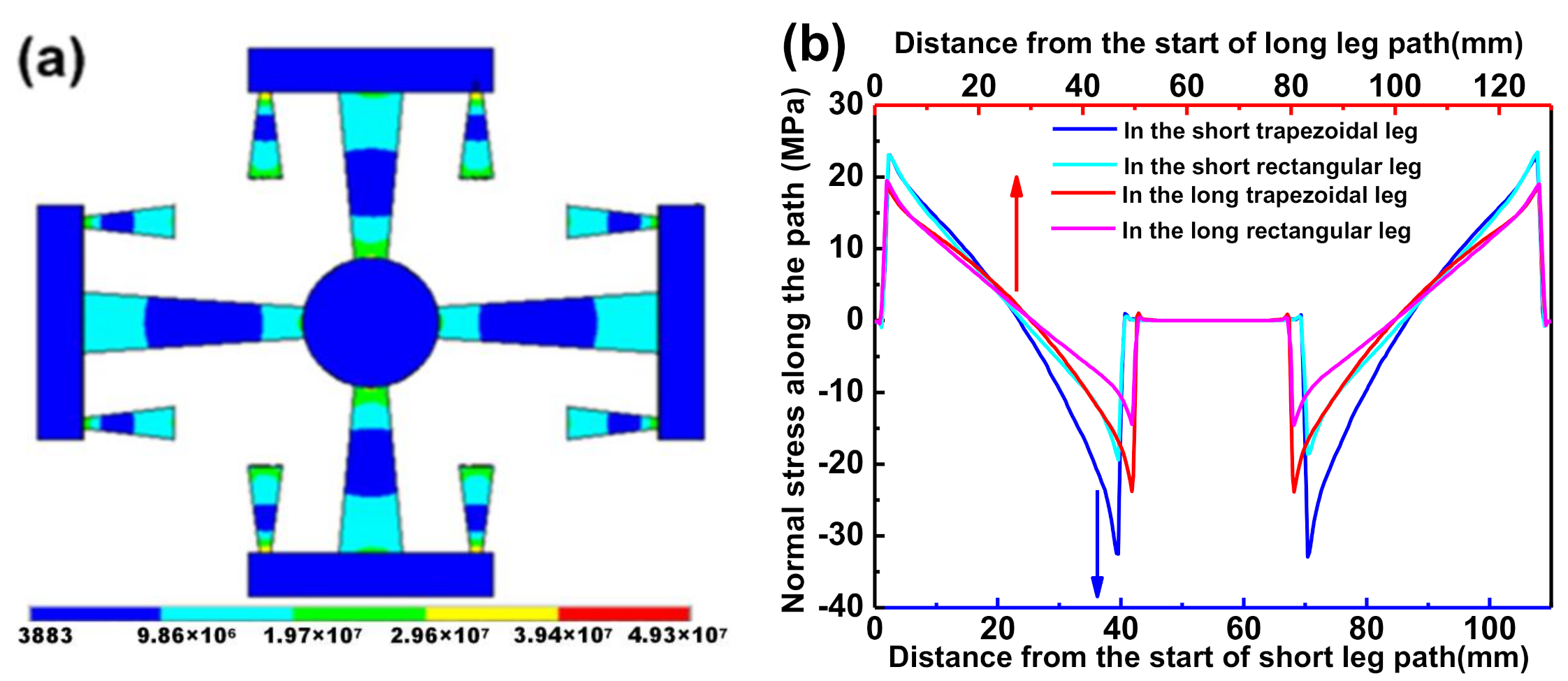




| Material Parameters | Dimension | ||||||
|---|---|---|---|---|---|---|---|
| Young Modulus (GPa) | Poisson’s Ratio | Density (kg/m3) | Length of Long Leg (mm) | Base Width (mm) | Thickness (mm) | L2/L1 | b/a |
| 198 | 0.3 | 7810 | 50 | 15 | 0.2 | 0.8 | 0.5 |
| Source of Compared Values | N1 a | N2 a | Deviation = (N2 − N1)/N2 × 100% | |
|---|---|---|---|---|
| Case 1 | Situation 1 b | 1.528 | 1.55 | 1.44% |
| Situation 2 b | 1.418 | 1.454 | 2.48% | |
| Case 2 | Situation 1 b | 1.675 | 1.615 | −3.71% |
| Situation 2 b | 1.36 | 1.429 | 4.83% | |
Publisher’s Note: MDPI stays neutral with regard to jurisdictional claims in published maps and institutional affiliations. |
© 2020 by the authors. Licensee MDPI, Basel, Switzerland. This article is an open access article distributed under the terms and conditions of the Creative Commons Attribution (CC BY) license (http://creativecommons.org/licenses/by/4.0/).
Share and Cite
Liu, Y.; Mo, S.; Shang, S.; Wang, H.; Wang, P.; Yang, K. Quad-Trapezoidal-Leg Orthoplanar Spring with Piezoelectric Plate for Enhancing the Performances of Vibration Energy Harvester. Energies 2020, 13, 5919. https://doi.org/10.3390/en13225919
Liu Y, Mo S, Shang S, Wang H, Wang P, Yang K. Quad-Trapezoidal-Leg Orthoplanar Spring with Piezoelectric Plate for Enhancing the Performances of Vibration Energy Harvester. Energies. 2020; 13(22):5919. https://doi.org/10.3390/en13225919
Chicago/Turabian StyleLiu, Yan, Shuting Mo, Siyao Shang, Hai Wang, Peng Wang, and Keyuan Yang. 2020. "Quad-Trapezoidal-Leg Orthoplanar Spring with Piezoelectric Plate for Enhancing the Performances of Vibration Energy Harvester" Energies 13, no. 22: 5919. https://doi.org/10.3390/en13225919
APA StyleLiu, Y., Mo, S., Shang, S., Wang, H., Wang, P., & Yang, K. (2020). Quad-Trapezoidal-Leg Orthoplanar Spring with Piezoelectric Plate for Enhancing the Performances of Vibration Energy Harvester. Energies, 13(22), 5919. https://doi.org/10.3390/en13225919






